Dishes with distinction
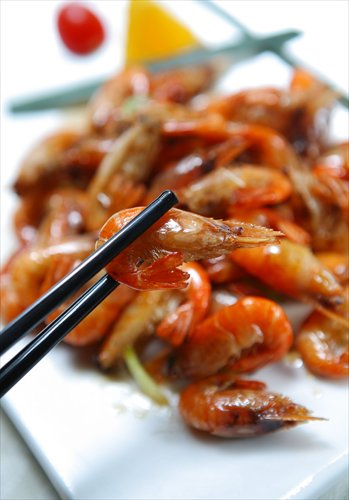
Speed is essential in cooking youbaoxia. Photo: CFP
A restaurant offering genuine Shanghai cuisine, Sanlin Benbang Guan, is welcoming a slew of new customers these days, after it appeared in the second season of the CCTV's documentary series A Bite of China which began broadcasting on April 18.
Diners crowd the restaurant to taste Shanghai cuisine dishes that have been passed on for the five generations of the family which runs the restaurant.
Located in Sanlin, Pudong New Area, the restaurant only offers some 10 old-fashioned square tables each seating eight people and a few long benches. It has four stoves and four chefs working constantly.
Most diners come to the restaurant, hoping to try kousansi, steamed strands of bamboo shoots, ham and chicken breast, the acclaimed specialty of the restaurant. The television series showed in detail how this was made.
Kousansi is one of the eight representative dishes of Shanghai cuisine. To cook the dish, the chef uses a small bowl with a hole in the base. First, he puts a slice of mushroom at the bottom of the bowl. Then he arranges strands of bamboo shoots, ham and chicken breast around the inside of the bowl before filling the rest of the bowl with more bamboo, ham, sauces and seasoning. The bowl is steamed vigorously for 10 minutes. When it is finished, the bowl is turned upside-down on the serving plate and drenched with a tasty chicken broth. Dinner is served!
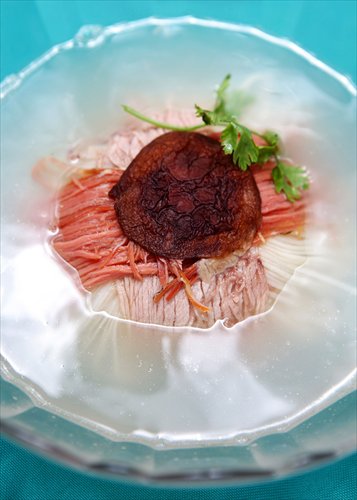
Kousansi is one of the eight representative dishes of Shanghai cuisine. Photo: CFP
Fascinating process
Diners are fascinated with the kousansi cooking process. The ingredients - bamboo shoots, ham and chicken breast - are commonly used in Chinese cuisine. But the way they are processed for this dish is not only different but demands skill and time. The chef has to first slice the bamboo shoots and the meat into slivers as thin as pieces of paper. Then he cuts these slices into small strands as fine as silk threads.
Someone reportedly once counted the strands in a bowl of kousansi and found around 2,000 strands all the same size. It takes a chef at least five years to achieve this level of skill. Because it usually takes an hour for a chef to prepare the materials for a bowl of kousansi, the restaurant can only serve four dishes of kousansi in a day, and diners have to order the dish in advance.
After the dish was shown on television, many diners called the restaurant wanting to enjoy it as well but the demand swamped the restaurant and owner, Li Mingfu, had to take the dish off the menu for the time being. Also the season for the spring bamboo shoots was just about over. Although the ingredients for traditional kousansi are chicken breast, ham and bamboo shoots, Li has found the chicken breast and ham can be replaced with pork which produces a different but impressive flavor. However the winter and spring bamboo shoots are irreplaceable in kousansi. "So when the spring bamboo shoots are not in the markets, customers have to wait for six months before they can enjoy the dish again," Li told the Wenhui Daily.
The other acclaimed dish filmed in the documentary was youbaoxia, sautéed shrimp. While it only takes five to seven seconds to cook this it takes a chef years to accumulate the skills to do this properly.
The chefs who cooked the two dishes in the television series are the twin sons of Li Mingfu, Li Wei and Li Yue, the fifth generation of the Li family. Every member on this family tree has contributed to the family business and helped bring it success.
The Shanghai cuisine started to develop in Sanlin as early as the Yuan Dynasty (1279-1368). Famous branches of the Shanghai-style cuisine in this area include the cuisines of the Lin, Chu, Zhao and Zhang families.
The cooking careers of the Li family started in the Qing Dynasty (1644-1911). At that time, most of the villagers in Sanlin were peasants and cooking was just a hobby for some of the farmers who enjoyed doing this for others. One of the best part-time cooks of the day was Li, whose dishes proved very popular with the other villagers.
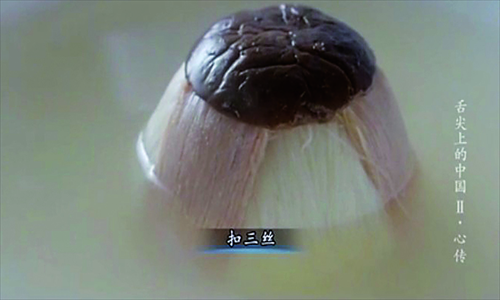
Bamboo shoots, ham and chicken breast are the basics for kousansi. Photo: Screen shots from CCTV's documentary series A Bite of China
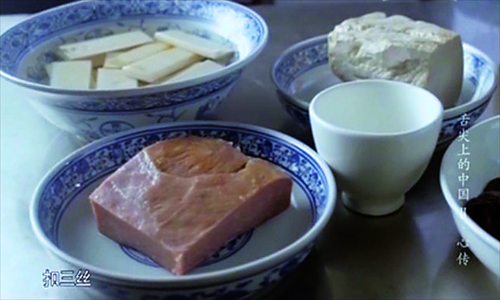
Bamboo shoots, ham, chicken breast and a bowl with a hole in the base are the basics for kousansi. Photo: Screen shots from CCTV's documentary series A Bite of China
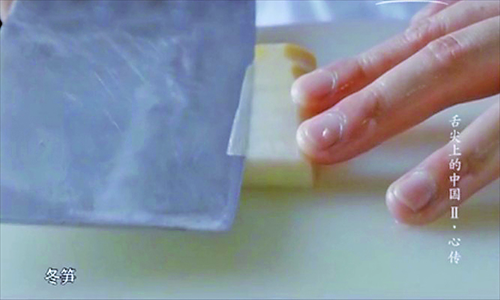
Bamboo shoots are the basics for kousansi. Photo: Screen shots from CCTV's documentary series A Bite of China

A bowl with a hole in the base is the basic for kousansi. Photo: Screen shots from CCTV's documentary series A Bite of China
Inventive and tasty
His son, Li Lingen, later became the founder of the local Sanlin cuisine and opened the famous Shanghai Dexing Guan restaurant chain.
At the end of the Qing Dynasty, several skilled local cooks opened restaurants offering Shanghai dishes and began competing for business. Li's inventive and tasty cooking soon attracted many of the Shanghai celebrities of the day, like Lu Xun, Bai Yang and Zhou Xinfang.
Li Borong, the son of Li Lingen, the third generation of the family of cooks and a national master chef, adapted cooking styles from across the country and then developed Sanlin cuisine even further by introducing Western methods like baking and grilling and combining these with Chinese cooking methods like stewing and steaming. This combination of Western and Chinese styles made Sanlin the success it was.
Li Mingfu and his two brothers are the fourth generation of the family. Li worked as the senior chef at a leading hotel and worked in Japan as a chef for two years. When he returned to Shanghai, he opened his own restaurant and his family cuisine, the Sanlin cuisine, was listed as an intangible heritage of Pudong New Area in 2008 - Li Mingfu was named as the heir.
Now, Li Mingfu is passing on his skills to his twin sons, Li Wei and Li Yue. Strictly speaking, Li Wei and Li Yue did not learn their cooking skills from their father or their grandfather. When they were 16, they were sent to work as assistant chefs at other leading restaurants. "Apprenticeships ended with our father's generation. My brother and I were trained in restaurant kitchens as if we were factory products manufactured on an assembly line," Li Yue told the Oriental Morning Post.
Some years ago, Li Yue quit his job as chef at the Shanghai Classical Hotel, a Shanghai restaurant that dates back more than 130 years, and returned home to help his father. Li Wei works as a nutritionist at Shanghai Ninth People's Hospital, but always helps out at the family business after work.
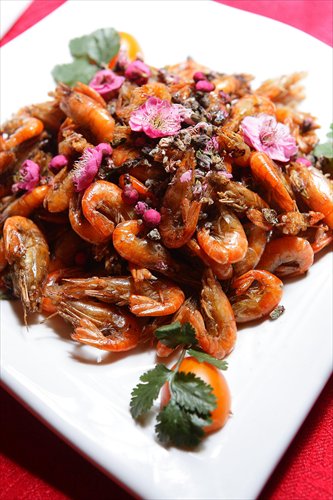
It takes a chef years to accumulate the skills to cook youbaoxia properly in five to seven seconds. Photo: CFP
Traditional influences
The two dishes featured in the television series did not just appear tasty because of the chefs - a lot of their attraction was the result of the filming created by the documentary crew. In one section, as the two chefs slice and dice the strands of meat and bamboo, their grandfather Li Borong plays the pipa (the traditional Chinese lute) in the background. It's a scene reminiscent of moments in Wong Kar-wai's acclaimed movie The Grandmaster.
But it was not easy for the crew to film this piece. It took them two days to finish shooting this section alone and even then chef Li Wei was not completely satisfied with his performance and the way the dish presented.
For documentary director Chen Lei, the series was problematic. He had difficulty selecting representative Shanghai cuisine dishes. But he had earlier decided to film as if he were making a martial arts movie so the rapid slicing skills required for kousansi and the speed needed to make youbaoxia were obvious choices.
In a remarkable family coincidence the son and daughter of the chef twins Li Wei and Li Yue were born on the same day, and they are now both 7. When asked if he would train his daughter to be a chef, Li Yue said he would not - being a chef was too demanding, he felt.
But Li Mingfu wants to pass on his skills to his family. However, knowing that a person has to have some talent in cooking before they can thrive, he does not intend to pressure his grandchildren. The twin brothers liked to watch their father and their grandfather cooking when they were little boys and they experimented themselves by cooking eggs in different styles.
They had extraordinary talents. "But there are fewer people willing to learn cooking these days. If members of the sixth generation of our family are not willing to learn to cook, I will not force them to. But I will keep looking for a suitable apprentice and pass on all my skills to him and her," Li Mingfu told the Oriental Morning Post.

The 10 tables at the Sanlin Benbang Guan are not enough to handle the crowds of customers these days. Photo: CFP
Negative comments
These days some negative comments about Sanlin Benbang Guan have been reported - especially after the restaurant was featured in A Bite of China. Some customers have complained that the restaurant was too crowded and the service was poor. Some worry that the prices will be raised because of its increasing popularity.
Li Mingfu quickly apologized for the limitations and not being able to cater adequately for all customers with only four chefs and four waiters on duty. The restaurant can only accommodate 12 tables at the most. He is planning to extend the restaurant soon so that they can serve more customers. He also promised not to raise prices, unless there were increases in the costs of the ingredients.
"Sanlin cuisine is ordinary cooking for ordinary people. It would be outrageous if we raised our prices just because we got to be famous," Li told the Wenhui Daily. He said the aim of his restaurant was to promote the local cuisine and not make big profits.
Compiled by Du Qiongfang